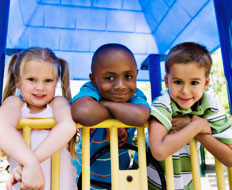Your playground is like a magnet. It attracts kids eager for fun and parents hungry for relaxation to your restaurant.
Unfortunately, it is also a magnet for microorganisms, including those that contribute to foodborne illness. On the playground, bacteria, fungi, and viruses pass from small hands to play equipment, to other hands, onto food and into mouths.
With children acting as they do—eating, playing, eating and playing some more—ensuring that playground equipment is properly cleaned and sanitized or disinfected is a critical component in providing a safe and inviting dining experience. Taking steps to encourage customer hand hygiene before and after playground use will also help keep children and parents healthy.
“Effective playground cleanliness requires cleaning, rinsing, and sanitizing or disinfecting equipment surfaces,” says Gina McDowell, Food Safety Technical Consultant at Ecolab.
Cleaning removes the visible dirt and other residues from surfaces and reduces the total microorganism count. It should be followed by rinsing.
Sanitizing—if an Environmental Protection Agency (EPA)-registered sanitizing product is used and procedures indicated on the product label are followed—helps reduce the count of a variety of potentially harmful microorganisms. Disinfecting provides an extra layer of protection by totally eliminating them, including hard-to-kill viruses.
How frequently should playground equipment be cleaned and sanitized or disinfected?
“Best practice is to follow the guidance for other non-food contact surfaces,” McDowell says. The Food and Drug Administration Food Code recommends cleaning non-food contact surfaces as often as needed to prevent the build-up of soil residues. Typical quick-service recommendations call for cleaning and sanitizing those surfaces daily, with spot cleaning throughout the day.
Certainly, anytime there is an incident involving vomit or other bodily secretions in the playground area, cleaning and disinfecting are imperative.
Just as promoting good hand hygiene among employees helps prevent the spread of illness, encouraging hand washing or sanitizing before children eat—and before they head to the playground—can have the same beneficial effect.
“Encourage parents and children to practice hand hygiene by posting hand-washing signage and providing convenient hand-washing facilities or hand-sanitizers near the playground entrance,” McDowell says.
Cleaning and sanitizing or disinfecting your restaurant playground are not easy tasks. But they are well worth the time and effort to help make sure your playground is not only fun, but also safe and healthy.
The FDA Food Safety website is a resource for information on making your quick serve “safer.”
By Dixie Berg for Ecolab












